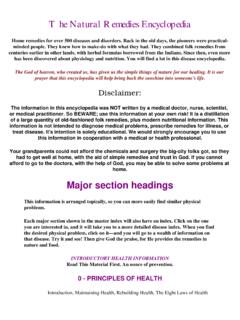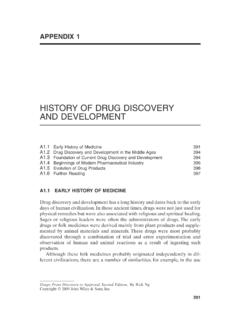Transcription of An Introduction to Pharmacology - EOLSS
1 UNESCO EOLSSSAMPLE CHAPTERSPHARMACOLOGY Vol. I - An Introduction to Pharmacology - H. Majewski encyclopedia of Life Support Systems ( EOLSS ) AN Introduction TO Pharmacology H. Majewski School of Medical Sciences, RMIT University, Australia Keywords: Pharmacology , receptors, ion-channels, pharmacokinetics, pharmacodynamics, pharmacogenomics, neuropharmacology, cardiovascular, reproductive, endocrine, pulmonary, gastrointestinal, analgesia, anesthesia, molecular, inflammation, autonomic Contents 1. History of Pharmacology 2. Pharmacodynamics and receptors 3. Molecular Pharmacology Receptors: Ligand Gated Ion Channels Receptors: G-protein Coupled Receptors Enzyme Linked Membrane Receptors Nuclear Receptor Family Ion Channels Molecular Basis of Bacterial Chemotherapy Molecular Basis of Viral Chemotherapy Molecular Basis of Cancer Chemotherapy 4.
2 Pharmacokinetics 5. Pharmacogenomics 6. Safety Pharmacology 7. Drug discovery 8. Clinical Pharmacology 9. Pharmacology of the nervous system Autonomic Pharmacology Neuropharmacology: Brain Neurotransmission Neuropsychopharmacology Pain and Analgesia Drugs used in Anesthesia 10. Muscle relaxants 11. Gastrointestinal Pharmacology 12. Poisons venoms and toxins 13. Reproductive Pharmacology 14. Drug therapy of inflammation Non Steroidal Anti-inflammatory Drugs Cromones Glucocorticoids Mediator Receptor Antagonists Disease Modifying Anti-rheumatoid Drugs 15. Immunopharmacology 16. Endocrine Pharmacology 17. Cardiovascular Pharmacology Heart Failure UNESCO EOLSSSAMPLE CHAPTERSPHARMACOLOGY Vol. I - An Introduction to Pharmacology - H. Majewski encyclopedia of Life Support Systems ( EOLSS ) Angina Hypertension Disturbances to Cardiac Rhythm Disease Modifying Drug Strategies in Cardiovascular Disease 18.
3 Pulmonary Pharmacology Allergies and Anaphylactic Shock Acknowledgements Glossary Bibliography Biographical Sketch Summary Broadly defined, Pharmacology is the study of the actions of chemicals on the body and most usually it is defined as chemicals that can have a therapeutic action to treat disease. Since it looks at the interaction between chemicals and body systems Pharmacology utilizes the basic disciplines of chemistry, biochemistry, physiology, pathology and microbiology in its practice. Pharmacology is a foundation science for pharmacy which is the rational prescribing of drugs to treat disease and the foundation science for toxicology which is the study of the toxic actions of chemicals on the body.
4 Pharmacological methodology in understanding chemical action is relevant for many areas of therapeutics including herbal medicines, Chinese medicine, natural products, as well as chemicals, therapeutic drugs and socially used drugs. Pharmacologic methodology serves to describe how a drug acts in the body and in many cases the scientific studies of drug action were instrumental in developing an understanding of body function in health and disease. Many of the fundamental discoveries in medical science were made as scientists sought to find explanations to explain drug action in the body. The divide between Pharmacology and physiology is esoteric with many of the early pioneers of medicine being claimed by both disciplines as key contributors.
5 In the Pharmacology theme whilst there is an organization on the basis of therapeutic area, there are also topics to define the basic scientific principles of Pharmacology . The theme is not a resource for therapeutic prescribing and the reader is directed to more precise prescribing information such as in the many national formularies ( the Australian Medicines Handbook, British National Formulary; United States Pharmacopeia and National Formulary; World Health Organisation Model Formulary). Comprehensive textbooks include: Rang and Dale s Pharmacology ; Goodman and Gilman s The Pharmacological Basis of Therapeutics; Basic and Clinical Pharmacology . 1. History of Pharmacology From the beginnings of time, Pharmacology has had a place in human history in all cultures.
6 The initial primitive Pharmacology knowledge developed from experiences on which plants when eaten were safe and which were toxic. In such a fashion a catalogue of good and bad evolved and was passed down through oral traditions. This was transformed over time to include natural sources which appeared to cure or ameliorate disease. In our earliest written histories descriptions of therapeutic natural products exist. In the Ebers papyrus, written in Egypt in the 16th century BCE, beer, turpentine, myrrh, juniper berries and poppy and other therapies were described to treat disease. UNESCO EOLSSSAMPLE CHAPTERSPHARMACOLOGY Vol. I - An Introduction to Pharmacology - H. Majewski encyclopedia of Life Support Systems ( EOLSS ) Similar historical records exist for most ancient civilizations including the Sumerian, Indian and Chinese.
7 There are many threads back into antiquity and the book History of Medicine by Lois Magner is a wonderful treatise describing the evolution of medicine and therapeutics. One thread that is easily followed is that of opium, which even today is the source of key modern day pain killers and exemplifies the evolution of Pharmacology . The story starts with the Sumerians around 3400 BCE who cultivated the opium poppy in lower Mesopotamia and recorded its actions in clay tablets. It was referred to as the joy plant and its reputation lead to its spread across neighboring civilizations such as Egypt. Around 460 BCE Hippocrates, a famous Greek physician and teacher of medicine, described opium as having narcotic properties and also described opium use in treating internal diseases.
8 Both Roman and Greek physicians did much to spread knowledge of opium's medical use. Even then, the addictive properties of opium were clear, properties which were to be implicated in serious social problems across the world which are evident even today. In 330 BCE, Alexander the Great introduced opium to Persia and India and by the year 400 it had reached China. In the 10th century, the noted Islamic physician Avicenna of Persia described opium as "the most powerful of stupefacients". About the year 1200 ancient Indian medical treatises The Shodal Gadanigrah and Sharangdhar Samahita describe the use of opium for diarrhea and sexual debility. In the 1300 s opium disappeared from European historical record and it was not until 1527 that opium was reintroduced into European medical literature by Paracelsus as laudanum which was prescribed as a painkiller.
9 The modern era began in 1680 when the English apothecary, Thomas Sydenham, introduced Sydenham's Laudanum which became prototypical for many opium proprietary brands and was used for numerous ailments. In 1803, the German Friedrich Sert rner dissolved opium in acid then neutralized it with ammonia. The result was morphine which, in contrast to raw opium, exhibited long-lasting and predictable effects. By 1827 morphine was in commercial manufacture. In 1874, English researcher, Wright synthesized heroin which went into commercial production in Germany in 1898. More recently, opioids and derivatives with a range of pharmacokinetic properties produce more effective control of pain.
10 The molecular basis of opioid action unraveled after Solomon Snyder and Candace Pert located the molecular site of action and discovered specific proteins which were activated by opioids in 1972. These opioid receptors were found in neural tissue and mediate the pain reducing effect. It was reasoned that if the receptors exist that they may form part of a physiological pathway. John Hughes and Hans Kosterlitz then discovered that humans produce endogenous morphine-like compounds, the enkephalins, which act on opioid receptors. Endorphins, which are human peptides also were discovered and also activate opioid receptors. The history of opioids above hint at two important pharmacological concepts the first is the ability to alter the duration of the effect as exemplified by the development of morphine and the second is the existence of receptors which transduce the biological UNESCO EOLSSSAMPLE CHAPTERSPHARMACOLOGY Vol.











